Abstract
The reverse cholesterol transport is initiated by the uptake of cholesterol into minor subfractions of high density lipoproteins (HDL) which contain either apolipoprotein (apo) A-I or apoE as their only apolipoproteins. From these initial acceptors, which are termed prebeta1-LpA-I and gamma-LpE, respectively, cell-derived cholesterol is transferred to LDL via the bulk of HDL termed alpha-LpA-I. In this study we analyzed the effect in plasma of the genetically determined apoE polymorphism on the formation of gamma-LpE, uptake and transfer of cell-derived cholesterol to LDL. Gamma-LpE was immunologically detectable in plasmas of individuals carrying at least one apoE3-allele but not in apoE3-free plasmas. During one minute incubation with [3H]cholesterol-labeled fibroblasts, gamma-LpE of plasmas from apoE3/3 subjects accumulated 7 and 13-fold more radioactivity than the respective fractions in plasmas from apoE2/2- and apoE4/4-subjects, respectively. Totally, 30% less [3H]cholesterol was released into plasmas of apoE2/2 and apoE4/4-individuals as compared with plasmas of apoE3/3-subjects. Moreover, plasmas of apoE3/3 individuals accumulated 50% and 65% more cell-derived [3H]cholesterol in alpha-LpA-I2 than plasmas of apoE4/4 and apoE2/2-subjects, respectively. These results indicate that the apoE-polymorphism is an important determinant of the uptake and transfer of cell-derived cholesterol in plasma.
Full text
PDF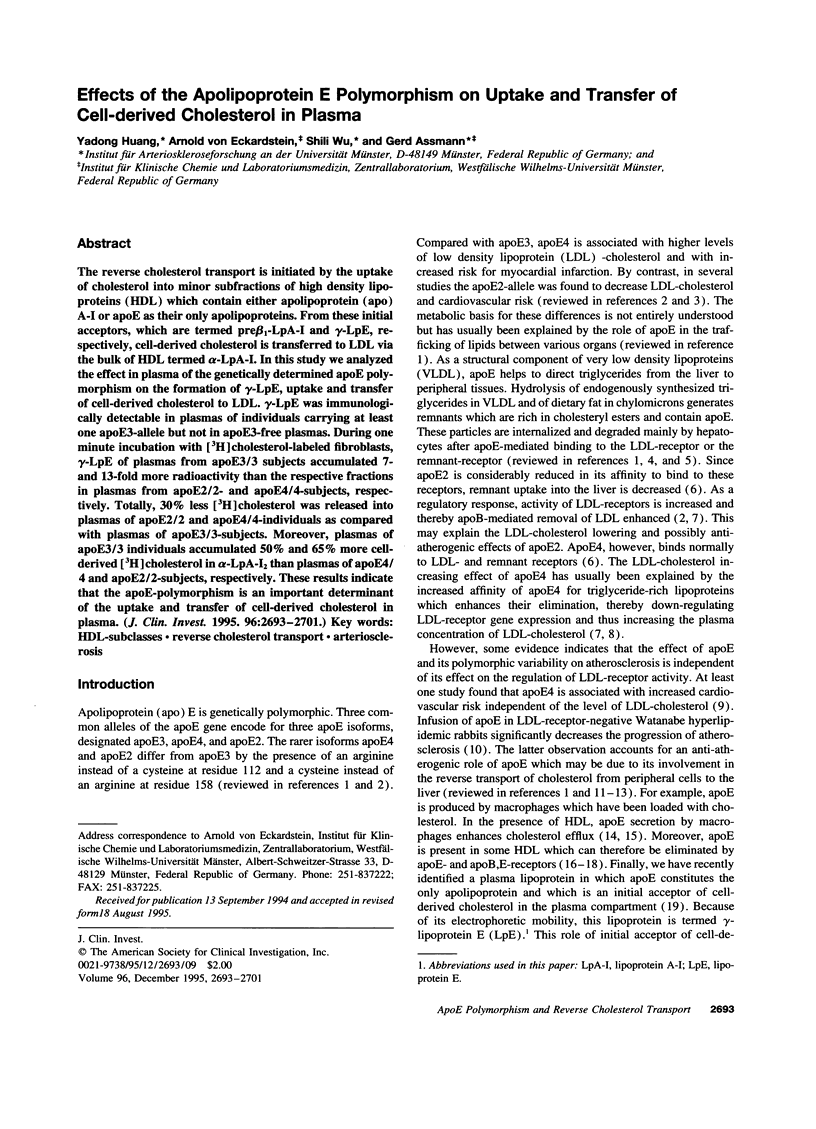
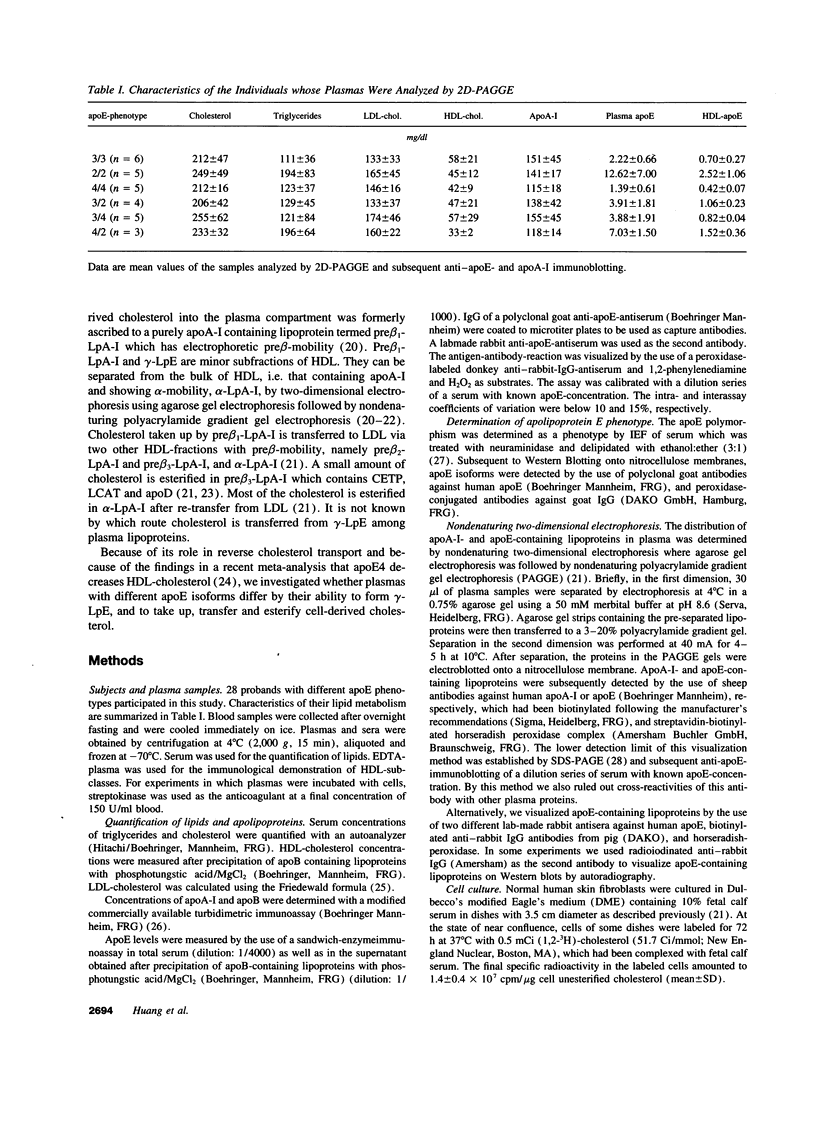
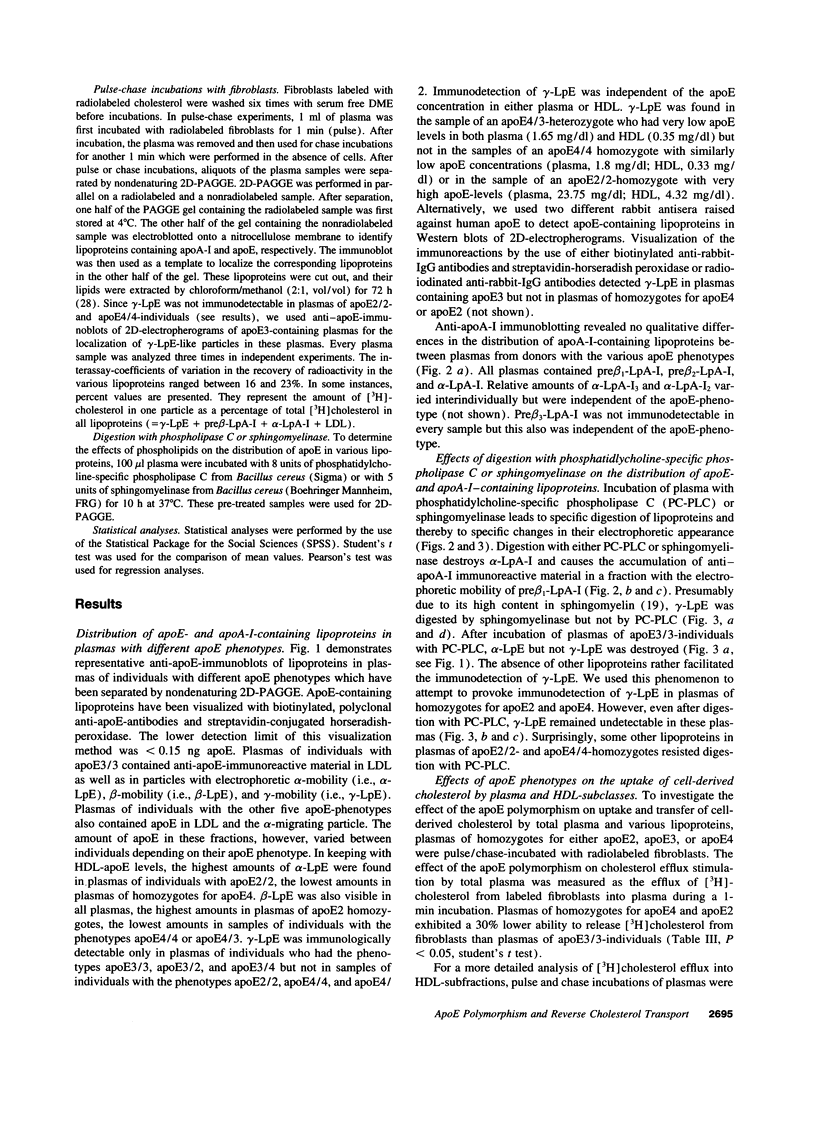
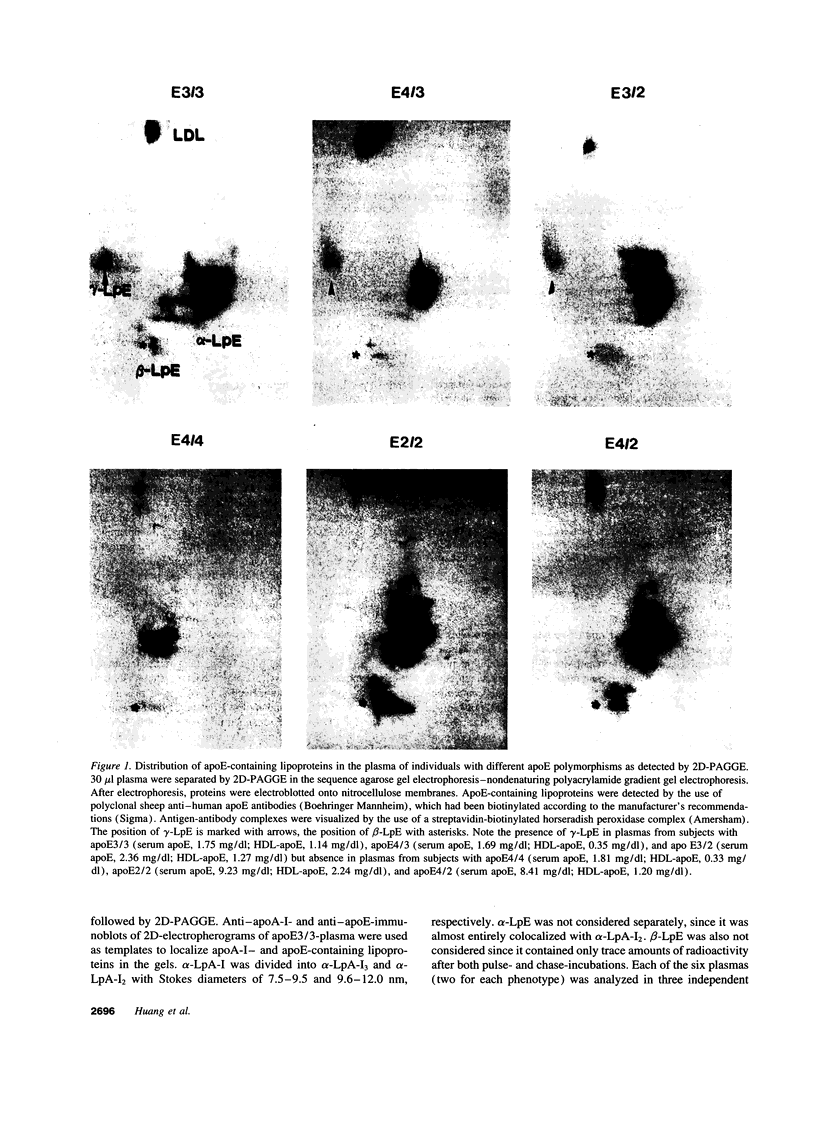
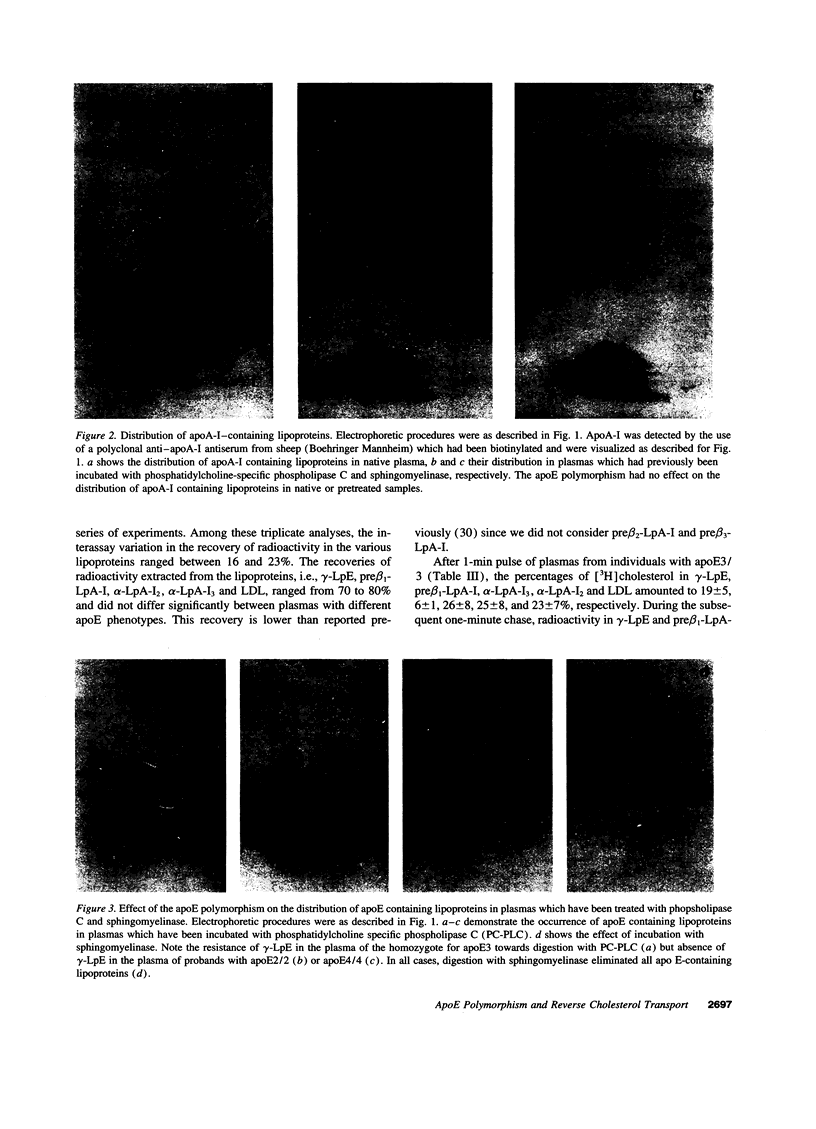
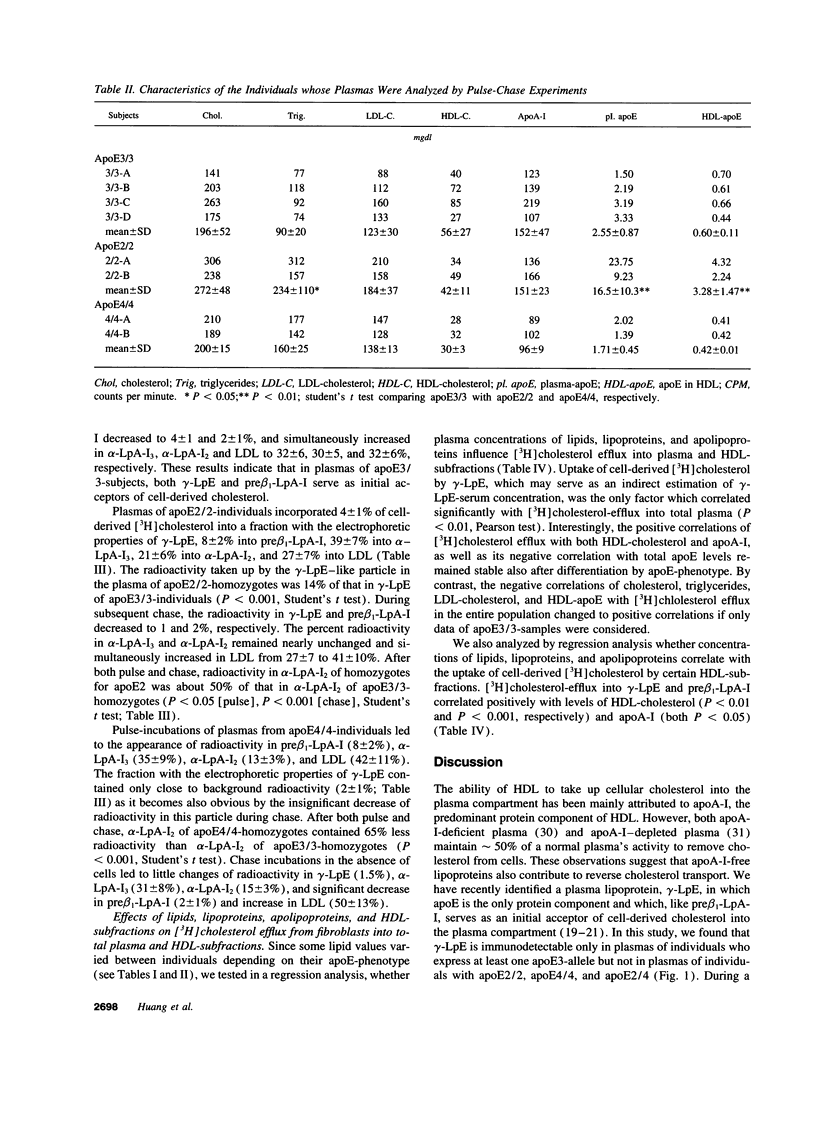
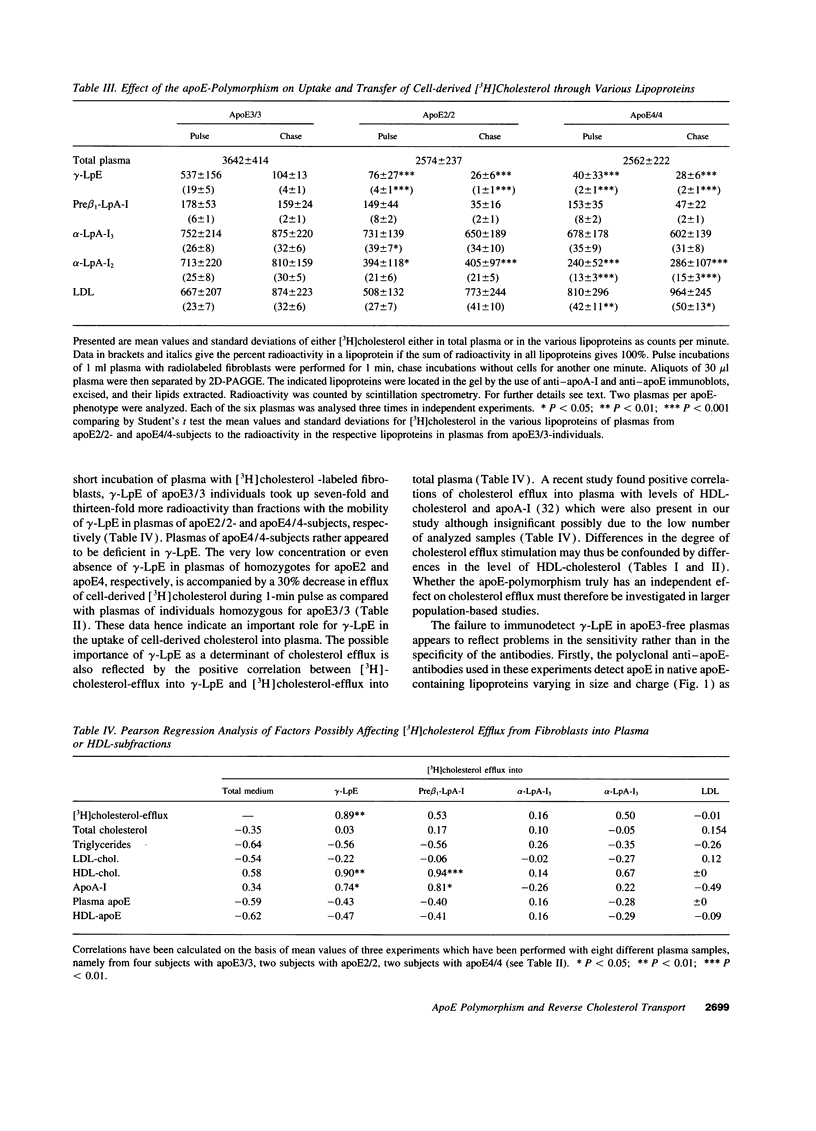
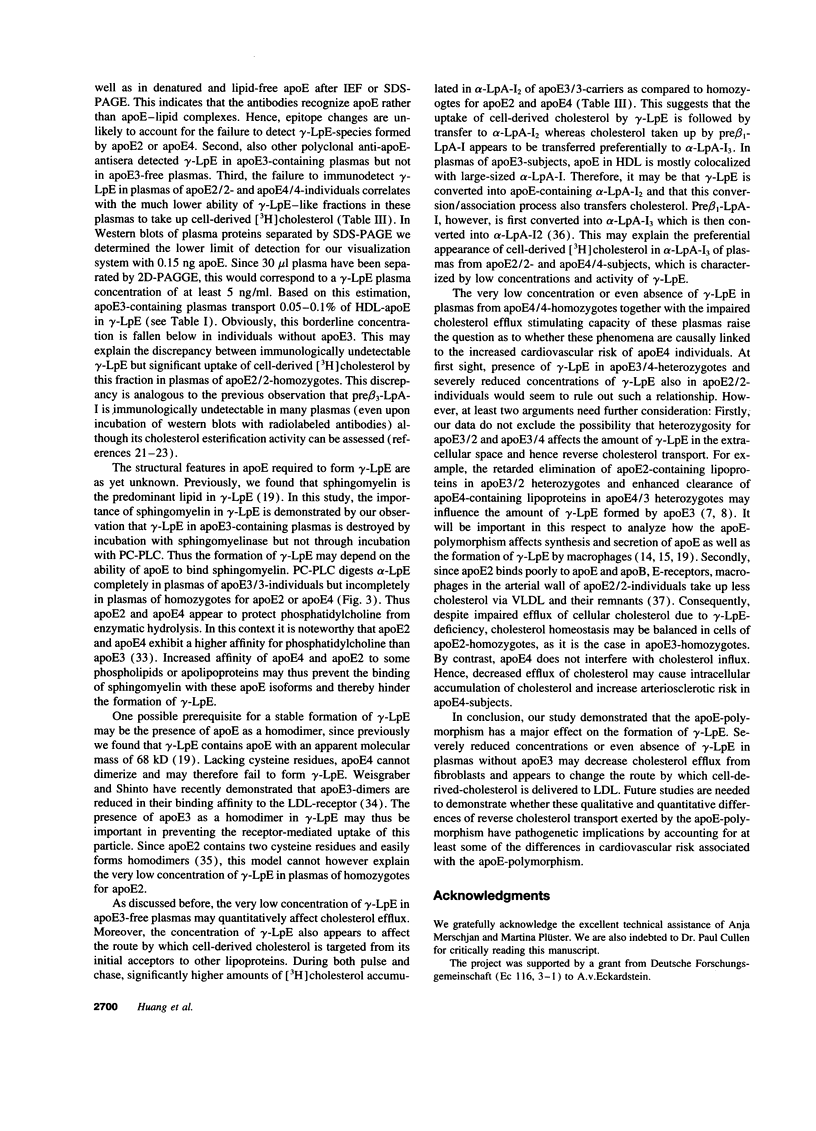
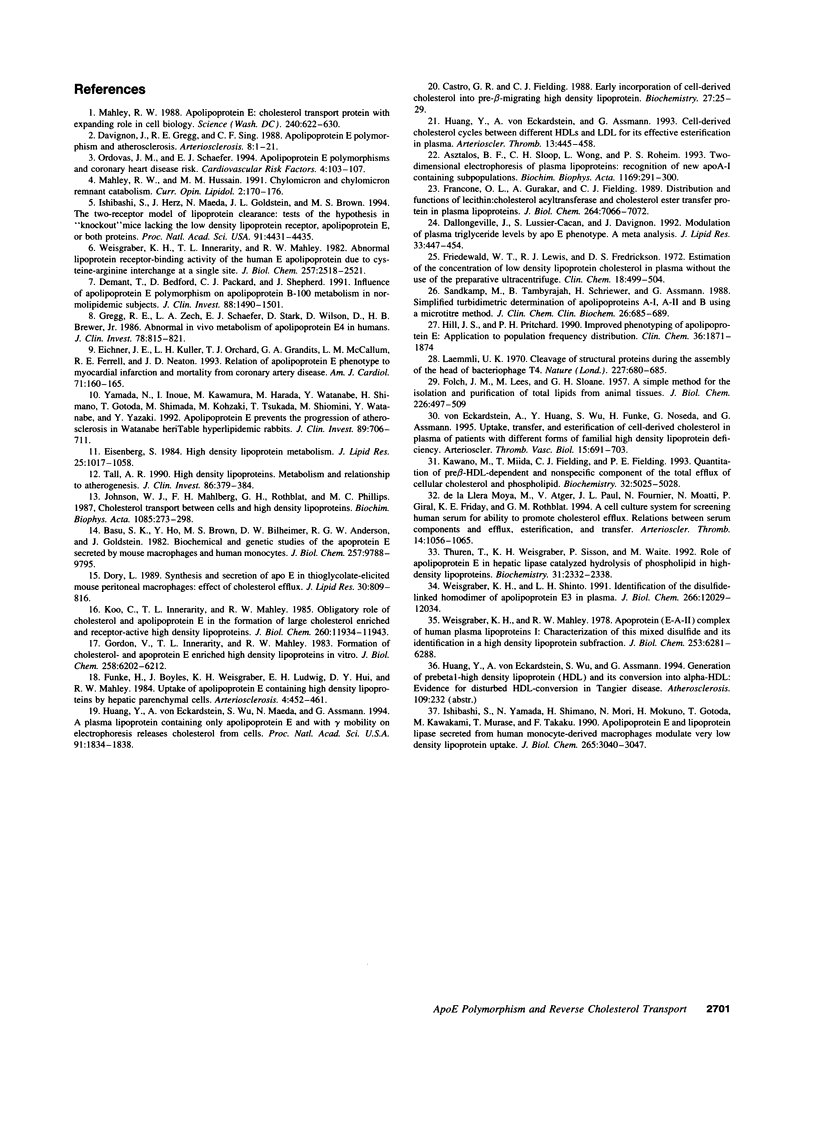
Images in this article
Selected References
These references are in PubMed. This may not be the complete list of references from this article.
- Asztalos B. F., Sloop C. H., Wong L., Roheim P. S. Two-dimensional electrophoresis of plasma lipoproteins: recognition of new apo A-I-containing subpopulations. Biochim Biophys Acta. 1993 Sep 8;1169(3):291–300. doi: 10.1016/0005-2760(93)90253-6. [DOI] [PubMed] [Google Scholar]
- Basu S. K., Ho Y. K., Brown M. S., Bilheimer D. W., Anderson R. G., Goldstein J. L. Biochemical and genetic studies of the apoprotein E secreted by mouse macrophages and human monocytes. J Biol Chem. 1982 Aug 25;257(16):9788–9795. [PubMed] [Google Scholar]
- Castro G. R., Fielding C. J. Early incorporation of cell-derived cholesterol into pre-beta-migrating high-density lipoprotein. Biochemistry. 1988 Jan 12;27(1):25–29. doi: 10.1021/bi00401a005. [DOI] [PubMed] [Google Scholar]
- Dallongeville J., Lussier-Cacan S., Davignon J. Modulation of plasma triglyceride levels by apoE phenotype: a meta-analysis. J Lipid Res. 1992 Apr;33(4):447–454. [PubMed] [Google Scholar]
- Davignon J., Gregg R. E., Sing C. F. Apolipoprotein E polymorphism and atherosclerosis. Arteriosclerosis. 1988 Jan-Feb;8(1):1–21. doi: 10.1161/01.atv.8.1.1. [DOI] [PubMed] [Google Scholar]
- Demant T., Bedford D., Packard C. J., Shepherd J. Influence of apolipoprotein E polymorphism on apolipoprotein B-100 metabolism in normolipemic subjects. J Clin Invest. 1991 Nov;88(5):1490–1501. doi: 10.1172/JCI115459. [DOI] [PMC free article] [PubMed] [Google Scholar]
- Dory L. Synthesis and secretion of apoE in thioglycolate-elicited mouse peritoneal macrophages: effect of cholesterol efflux. J Lipid Res. 1989 Jun;30(6):809–816. [PubMed] [Google Scholar]
- Eichner J. E., Kuller L. H., Orchard T. J., Grandits G. A., McCallum L. M., Ferrell R. E., Neaton J. D. Relation of apolipoprotein E phenotype to myocardial infarction and mortality from coronary artery disease. Am J Cardiol. 1993 Jan 15;71(2):160–165. doi: 10.1016/0002-9149(93)90732-r. [DOI] [PubMed] [Google Scholar]
- Eisenberg S. High density lipoprotein metabolism. J Lipid Res. 1984 Oct;25(10):1017–1058. [PubMed] [Google Scholar]
- FOLCH J., LEES M., SLOANE STANLEY G. H. A simple method for the isolation and purification of total lipides from animal tissues. J Biol Chem. 1957 May;226(1):497–509. [PubMed] [Google Scholar]
- Francone O. L., Gurakar A., Fielding C. Distribution and functions of lecithin:cholesterol acyltransferase and cholesteryl ester transfer protein in plasma lipoproteins. Evidence for a functional unit containing these activities together with apolipoproteins A-I and D that catalyzes the esterification and transfer of cell-derived cholesterol. J Biol Chem. 1989 Apr 25;264(12):7066–7072. [PubMed] [Google Scholar]
- Friedewald W. T., Levy R. I., Fredrickson D. S. Estimation of the concentration of low-density lipoprotein cholesterol in plasma, without use of the preparative ultracentrifuge. Clin Chem. 1972 Jun;18(6):499–502. [PubMed] [Google Scholar]
- Funke H., Boyles J., Weisgraber K. H., Ludwig E. H., Hui D. Y., Mahley R. W. Uptake of apolipoprotein E-containing high density lipoproteins by hepatic parenchymal cells. Arteriosclerosis. 1984 Sep-Oct;4(5):452–461. doi: 10.1161/01.atv.4.5.452. [DOI] [PubMed] [Google Scholar]
- Gordon V., Innerarity T. L., Mahley R. W. Formation of cholesterol- and apoprotein E-enriched high density lipoproteins in vitro. J Biol Chem. 1983 May 25;258(10):6202–6212. [PubMed] [Google Scholar]
- Gregg R. E., Zech L. A., Schaefer E. J., Stark D., Wilson D., Brewer H. B., Jr Abnormal in vivo metabolism of apolipoprotein E4 in humans. J Clin Invest. 1986 Sep;78(3):815–821. doi: 10.1172/JCI112645. [DOI] [PMC free article] [PubMed] [Google Scholar]
- Hill J. S., Pritchard P. H. Improved phenotyping of apolipoprotein E: application to population frequency distribution. Clin Chem. 1990 Nov;36(11):1871–1874. [PubMed] [Google Scholar]
- Huang Y., von Eckardstein A., Assmann G. Cell-derived unesterified cholesterol cycles between different HDLs and LDL for its effective esterification in plasma. Arterioscler Thromb. 1993 Mar;13(3):445–458. doi: 10.1161/01.atv.13.3.445. [DOI] [PubMed] [Google Scholar]
- Huang Y., von Eckardstein A., Wu S., Maeda N., Assmann G. A plasma lipoprotein containing only apolipoprotein E and with gamma mobility on electrophoresis releases cholesterol from cells. Proc Natl Acad Sci U S A. 1994 Mar 1;91(5):1834–1838. doi: 10.1073/pnas.91.5.1834. [DOI] [PMC free article] [PubMed] [Google Scholar]
- Ishibashi S., Herz J., Maeda N., Goldstein J. L., Brown M. S. The two-receptor model of lipoprotein clearance: tests of the hypothesis in "knockout" mice lacking the low density lipoprotein receptor, apolipoprotein E, or both proteins. Proc Natl Acad Sci U S A. 1994 May 10;91(10):4431–4435. doi: 10.1073/pnas.91.10.4431. [DOI] [PMC free article] [PubMed] [Google Scholar]
- Ishibashi S., Yamada N., Shimano H., Mori N., Mokuno H., Gotohda T., Kawakami M., Murase T., Takaku F. Apolipoprotein E and lipoprotein lipase secreted from human monocyte-derived macrophages modulate very low density lipoprotein uptake. J Biol Chem. 1990 Feb 25;265(6):3040–3047. [PubMed] [Google Scholar]
- Johnson W. J., Mahlberg F. H., Rothblat G. H., Phillips M. C. Cholesterol transport between cells and high-density lipoproteins. Biochim Biophys Acta. 1991 Oct 1;1085(3):273–298. doi: 10.1016/0005-2760(91)90132-2. [DOI] [PubMed] [Google Scholar]
- Kawano M., Miida T., Fielding C. J., Fielding P. E. Quantitation of pre beta-HDL-dependent and nonspecific components of the total efflux of cellular cholesterol and phospholipid. Biochemistry. 1993 May 18;32(19):5025–5028. doi: 10.1021/bi00070a008. [DOI] [PubMed] [Google Scholar]
- Koo C., Innerarity T. L., Mahley R. W. Obligatory role of cholesterol and apolipoprotein E in the formation of large cholesterol-enriched and receptor-active high density lipoproteins. J Biol Chem. 1985 Oct 5;260(22):11934–11943. [PubMed] [Google Scholar]
- Laemmli U. K. Cleavage of structural proteins during the assembly of the head of bacteriophage T4. Nature. 1970 Aug 15;227(5259):680–685. doi: 10.1038/227680a0. [DOI] [PubMed] [Google Scholar]
- Mahley R. W. Apolipoprotein E: cholesterol transport protein with expanding role in cell biology. Science. 1988 Apr 29;240(4852):622–630. doi: 10.1126/science.3283935. [DOI] [PubMed] [Google Scholar]
- Sandkamp M., Tambyrajah B., Schriewer H., Assmann G. Simplified turbidimetric determination of apolipoproteins A-I, A-II and B using a microtitre method. J Clin Chem Clin Biochem. 1988 Nov;26(11):685–688. doi: 10.1515/cclm.1988.26.11.685. [DOI] [PubMed] [Google Scholar]
- Tall A. R. Plasma high density lipoproteins. Metabolism and relationship to atherogenesis. J Clin Invest. 1990 Aug;86(2):379–384. doi: 10.1172/JCI114722. [DOI] [PMC free article] [PubMed] [Google Scholar]
- Thuren T., Weisgraber K. H., Sisson P., Waite M. Role of apolipoprotein E in hepatic lipase catalyzed hydrolysis of phospholipid in high-density lipoproteins. Biochemistry. 1992 Mar 3;31(8):2332–2338. doi: 10.1021/bi00123a018. [DOI] [PubMed] [Google Scholar]
- Weisgraber K. H., Innerarity T. L., Mahley R. W. Abnormal lipoprotein receptor-binding activity of the human E apoprotein due to cysteine-arginine interchange at a single site. J Biol Chem. 1982 Mar 10;257(5):2518–2521. [PubMed] [Google Scholar]
- Weisgraber K. H., Mahley R. W. Apoprotein (E--A-II) complex of human plasma lipoproteins. I. Characterization of this mixed disulfide and its identification in a high density lipoprotein subfraction. J Biol Chem. 1978 Sep 10;253(17):6281–6288. [PubMed] [Google Scholar]
- Weisgraber K. H., Shinto L. H. Identification of the disulfide-linked homodimer of apolipoprotein E3 in plasma. Impact on receptor binding activity. J Biol Chem. 1991 Jun 25;266(18):12029–12034. [PubMed] [Google Scholar]
- Yamada N., Inoue I., Kawamura M., Harada K., Watanabe Y., Shimano H., Gotoda T., Shimada M., Kohzaki K., Tsukada T. Apolipoprotein E prevents the progression of atherosclerosis in Watanabe heritable hyperlipidemic rabbits. J Clin Invest. 1992 Feb;89(2):706–711. doi: 10.1172/JCI115639. [DOI] [PMC free article] [PubMed] [Google Scholar]
- de la Llera Moya M., Atger V., Paul J. L., Fournier N., Moatti N., Giral P., Friday K. E., Rothblat G. A cell culture system for screening human serum for ability to promote cellular cholesterol efflux. Relations between serum components and efflux, esterification, and transfer. Arterioscler Thromb. 1994 Jul;14(7):1056–1065. doi: 10.1161/01.atv.14.7.1056. [DOI] [PubMed] [Google Scholar]
- von Eckardstein A., Huang Y., Wu S., Funke H., Noseda G., Assmann G. Reverse cholesterol transport in plasma of patients with different forms of familial HDL deficiency. Arterioscler Thromb Vasc Biol. 1995 May;15(5):691–703. doi: 10.1161/01.atv.15.5.691. [DOI] [PubMed] [Google Scholar]












